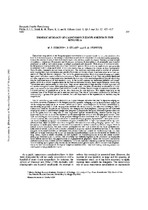| dc.contributor.author | Gibbons, Mark J. | |
| dc.contributor.author | Stuart, V. | |
| dc.contributor.author | Verheye, H.M. | |
| dc.date.accessioned | 2012-01-20T13:23:13Z | |
| dc.date.available | 2012-01-20T13:23:13Z | |
| dc.date.issued | 1992 | |
| dc.identifier.citation | Gibbons, M.J., Stuart, V., & Verheye, H.M. (1992). Trophic ecology of carnivorous zooplankton in the Benguela. South African Journal of Marine Science 12: 421-437 | en_US |
| dc.identifier.issn | 0257-7615 | |
| dc.identifier.uri | http://hdl.handle.net/10566/305 | |
| dc.description.abstract | Carnivorous zooplankton in the Benguela system have tended to be ignored by all but early taxonomists and a handful of recent researchers. An attempt is made here to address the importance of carnivores in this system but, because the database is poor, it was necessary to apply material from outside the region. The taxa covered include ctenophores, cnidarians (Scyphozoa and Hydrozoa, including Siphonophora), chaetognaths and hyperiid amphipods as well as such minor groups as pelagic gastropods and decapods. Most groups of carnivores within the Benguela are represented by only one or two "common" species. These tend to be epiplanktonic and generally concentrated inshore of the shelf-break, where their distributions are influenced by changes in local hydrography. Their densities frequently exceed those of herbivores. The dominant carnivores share a number of attributes: wide-ranging diets, high assimilation and growth efficiencies and mostly a Type I functional response to food concentration. They fall into two categories. The first is the gelatinous species, which have short lifespans and exhibit rapid growth and often massive reproductive response to high concentrations of food. They are patchily distributed and some appear to have behavioural traits that enable them to stay within localized patches of prey on which they may be dependent because of high metabolic costs. In the second category are crustacean predators and chaetognaths which have slower response times to the food environment but may have longer lifespans, lower daily maintenance needs and an ability to store lipids. They are less dependent on high densities of food organisms and can survive throughout winter, when gelatinous predators are rare. The effect of predation on abundance of copepods is estimated on the basis of both published and unpublished data. Should swarms of predators coincide with a critical gateway of zooplankton or larvae, then there may be total depletion. This applies especially to the nearshore zone of the West Coast and to semi-enclosed bays. The role of carnivorous zooplankton in the diets of commercially important fish species is stressed, but their importance in the regeneration of nutrients may be insignificant. | en_US |
| dc.language.iso | en | en_US |
| dc.publisher | NISC and Taylor & Francis | en_US |
| dc.rights | The South African Journal of Marine Science (now African Journal Marine Science) is published by NISC (Pty) Ltd and Taylor & Francis and available online at http://www.tandfonline.com/loi/tams20. Permission was granted by publisher for reproduction of this file. | |
| dc.subject | Zooplankton | en_US |
| dc.subject | Feeding | en_US |
| dc.subject | Trophic impact | en_US |
| dc.subject | Benguela upwelling ecosystem | en_US |
| dc.subject | Chaetognaths | en_US |
| dc.subject | Hyperiid amphipods | en_US |
| dc.subject | Jellyfish | en_US |
| dc.subject | Decapods | en_US |
| dc.subject | Carnivory | en_US |
| dc.title | Trophic ecology of carnivorous zooplankton in the Benguela | en_US |
| dc.type | Article | en_US |
| dc.privacy.showsubmitter | true | |
| dc.status.ispeerreviewed | true | |

